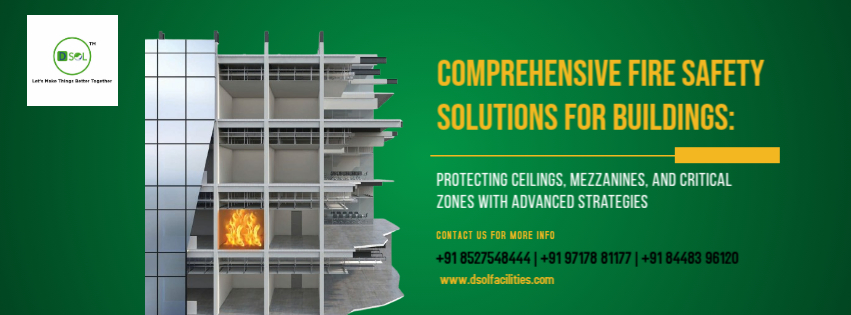Fire safety is a critical component of modern building management. Whether it’s a commercial complex, industrial facility, or residential high-rise, ensuring comprehensive protection against fire hazards is essential to safeguard lives, property, and infrastructure. Buildings often contain multiple risk areas such as ceilings, mezzanines, and critical zones that require specialized safety measures. Implementing advanced fire safety solutions helps prevent accidents, minimizes damage, and ensures compliance with national and international safety standards.
Understanding Fire Hazards in Buildings
Buildings face a variety of fire hazards, which can arise from electrical failures, combustible materials, improper storage practices, or human negligence. Ceilings, mezzanines, and protected zones often represent high-risk areas due to limited accessibility and complex structural layouts. Without proper fire safety measures, these areas can exacerbate the spread of fire, making evacuation and firefighting more challenging.
Ceilings: Hidden Fire Risks
Ceilings are often overlooked in fire safety planning, yet they play a significant role in fire propagation. Suspended ceilings can conceal electrical wiring, HVAC ducts, and other critical infrastructure, which may ignite under high heat or short-circuit conditions. Additionally, materials used in ceiling construction, such as wood, plaster, or insulation panels, can contribute to fire load. Advanced fire safety solutions focus on fire-resistant ceiling materials, fire barriers, and early detection systems to prevent rapid fire spread.
Mezzanines: Elevated Risk Zones
Mezzanines, commonly found in industrial and commercial buildings, are intermediate floors that can create unique fire challenges. These structures often house storage items, machinery, or office spaces, making them potential ignition points. Their elevated position can complicate firefighting operations and evacuation routes. Implementing specialized fire suppression systems, smoke detectors, and strategic compartmentalization ensures mezzanines remain safe during fire incidents.
Critical Zones: Protecting High-Risk Areas
Critical zones include server rooms, chemical storage areas, electrical panels, and other sections where fire incidents can lead to catastrophic outcomes. Protecting these zones requires tailored solutions such as gas-based suppression systems, automatic sprinklers, and heat-activated alarms. These measures are designed to control fire at the source and prevent it from spreading to adjacent areas.
Key Components of Fire Safety Solutions
A comprehensive fire safety strategy integrates multiple layers of protection, combining technology, infrastructure, and operational protocols. The following components are essential for effective fire safety in buildings:
Fire Detection Systems
Early detection is the cornerstone of fire safety. Smoke detectors, heat sensors, and flame detectors are strategically installed to identify fire hazards promptly. Advanced systems can integrate with building management software, triggering alarms and activating suppression systems automatically.
Fire Suppression Systems
Suppression systems are critical for controlling fire before it escalates. These include water-based sprinklers, foam systems, gas suppression systems, and specialized extinguishers for electrical or chemical fires. Selection depends on the type of risk present in ceilings, mezzanines, and critical zones.
Fire-Resistant Materials
Using fire-resistant construction materials significantly reduces the risk of fire spread. Ceilings, walls, and mezzanine structures constructed with fire-rated boards, metals, or treated wood ensure structural integrity during a fire. Protective coatings and insulation also enhance safety without compromising aesthetics.
Emergency Planning and Evacuation
Even with advanced systems, human safety depends on well-defined emergency protocols. Clear signage, escape routes, fire drills, and staff training are critical elements of an effective fire safety plan. Special attention must be given to mezzanines and protected zones, where evacuation can be more complex.
Monitoring and Maintenance
Regular inspection and maintenance of fire safety systems are essential for reliability. Automated monitoring solutions can provide real-time data on system performance, detect malfunctions, and ensure compliance with safety standards. Scheduled maintenance of sprinklers, detectors, and alarms prevents system failures during emergencies.
Advanced Strategies for Fire Safety
Modern fire safety solutions leverage technology to enhance protection in high-risk areas. Advanced strategies include:
- Integrated Building Management Systems – Combining fire detection, suppression, and alarm systems into a centralized control hub allows instant response and efficient monitoring.
- Compartmentalization – Dividing large spaces into smaller sections with fire barriers limits the spread of fire, particularly in mezzanines and ceiling voids.
- High-Sensitivity Smoke Detection – Ideal for critical zones like server rooms or chemical storage, these systems detect even minimal smoke particles.
- Automated Fire Suppression – Gas-based or foam systems automatically engage in critical zones to extinguish fires without human intervention.
- Thermal Imaging & Infrared Sensors – Early identification of hotspots helps prevent fire incidents before they escalate.
Benefits of Comprehensive Fire Safety Solutions
Implementing advanced fire safety solutions offers multiple benefits for building owners, occupants, and stakeholders:
- Enhanced Life Safety – Protects occupants by providing early warnings and safe evacuation routes.
- Property Protection – Minimizes damage to structures, equipment, and inventory.
- Regulatory Compliance – Ensures adherence to fire safety standards and local building codes.
- Business Continuity – Reduces downtime and financial losses due to fire incidents.
- Peace of Mind – Occupants and management can operate confidently knowing safety measures are in place.
Fire Safety Planning for Indian Buildings
In India, urban and industrial buildings face unique challenges such as high population density, mixed-use structures, and varying adherence to fire codes. Therefore, adopting comprehensive solutions that consider ceiling layouts, mezzanine access, and critical operational zones is essential. Collaboration with professional fire safety consultants ensures site-specific strategies that are both practical and effective.
Practical Steps for Implementation
- Conduct a detailed fire risk assessment covering ceilings, mezzanines, and critical zones.
- Install detection and suppression systems tailored to specific areas.
- Train building staff and occupants in emergency response procedures.
- Regularly test and maintain fire safety equipment.
- Update safety plans as the building layout, occupancy, or function changes.
Conclusion
Fire safety in buildings is an evolving domain requiring strategic planning, advanced technology, and ongoing vigilance. By focusing on ceilings, mezzanines, and critical zones, building managers can reduce risk, protect lives, and ensure operational continuity. Advanced fire safety solutions not only meet regulatory standards but also elevate the value and reputation of commercial and residential structures.
For Indian buildings, adopting a professional and structured approach ensures preparedness against fire incidents and supports sustainable, safe urban development.
D-SOL Facilities
D-SOL Facilities offers comprehensive fire safety solutions for commercial, residential, and industrial buildings. With expertise in advanced detection systems, fire suppression strategies, and risk assessment, D-SOL ensures every building achieves the highest safety standards. Their services include installation, monitoring, and maintenance of fire safety equipment, tailored strategies for ceilings, mezzanines, and critical zones, and consultation for regulatory compliance. Leveraging cutting-edge technology and industry best practices, D-SOL Facilities delivers solutions that prioritize life safety, property protection, and operational efficiency.
Contact Us:
Call for reservation: +91 8527548444 | +91 97178 81177 | +91 84483 96120
Email: rohit@dsolfacilities.com | hemraj@dsolfacilities.com
Website: www.dsolfacilities.com

